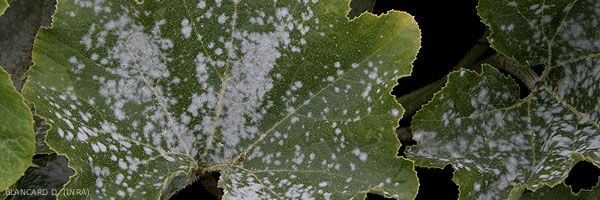
Podosphaera xanthii (Castagne) U. Braun & Shishkoff
Golovinomyces cichoracearum (DC.) V.P. Heluta, (1988) var. cichoracearum
Powdery mildew or "white"
- classification : Fungi, Ascomycota, Leotiomycetes, Leotiomycetidae, Erysiphales, Erysiphaceae
- English names: powdery mildew, white mold; Spanish denomination: oidio
The powdery mildew (also known as "white" or "blanquet") is a cosmopolitan fungal disease that is observed in all Cucurbitaceae production areas in the world, and particularly in France. It is one of the most frequent and destructive leaf diseases of the foliage, which is rampant both in greenhouse and in the field. Affecting a large proportion of the foliage, in particular the leaves which show premature senescence, it is the cause of significant yield losses, and a decrease in the quality of the fruits and their shelf life. Let us add that the oidia plants, rather devoid of leaves, have their fruits more exposed to solar burns .
Several fungi can be responsible for this disease on the different species of this botanical family: two fungi are widely reported and recently renamed: Podosphaera xanthii (normally ex Sphaerotheca fuliginea ) and Golovinomyces cichoracearum var. cichoracearum (ex Erysiphe cichoracearum ). The synonymy of the first species which is not mentioned in Index fungorum is rather confused.
Another rather confidential fungus in this botanical family, Leveillula taurica , which can sometimes attack cucumber, but this internal powdery mildew causes very different symptoms.
Depending on the country, the climatic conditions involved, the cultivated Cucurbits, but also the strains of these fungi raging (they have variable parasitic specializations), powdery mildew may be caused by one or other of these fungal species, or by a combination of the two.





